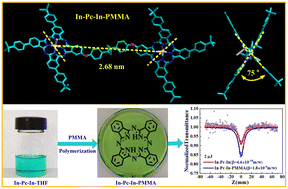Dinuclear indium phthalocyanine doped in PMMA glass used as nonlinear optical limiter
Abstract
The development of effective laser protectors to protect human eyes and all optical and photoelectric sensors from temporary or permanent damage caused by laser beams is both of great military significance and a focus of social and public security. In this work, a blue glass of In-Pc-In-PMMA is prepared by doping dinuclear indium phthalocyanine (In-Pc-In) into polymethyl methacrylate (PMMA) glass. The photophysical and nonlinear optical limiting behaviors are investigated and compared with In-Pc-In-THF solution (In-Pc-In-THF). The results indicate that the fluorescence lifetimes of In-Pc-In-THF are τ1 = 0.49 ns (A1 = 9.3%) for the monomer and τ2 = 5.51 ns (A2 = 90.7%) for the dimer. However, for the In-Pc-In-PMMA sample, the fluorescence lifetimes are significantly different from those of In-Pc-In-THF, whose fluorescence lifetimes are τ1 = 1.16 ns (A1 = 51.4%) for the monomer and τ2 = 4.47 ns (A2 = 48.6%) for the dimer, indicating that the fluorescence lifetimes of In-Pc-In-PMMA are dominated by monomers and supplemented by dimers. As a result, the In-Pc-In-PMMA glass presents a larger nonlinear absorption coefficient than that of In-Pc-In-THF solution, which provides a new concept for developing high-performance and practical optical-limiting devices.



 Please wait while we load your content...
Please wait while we load your content...